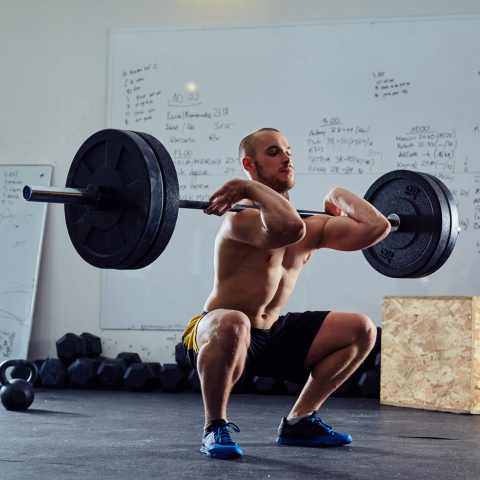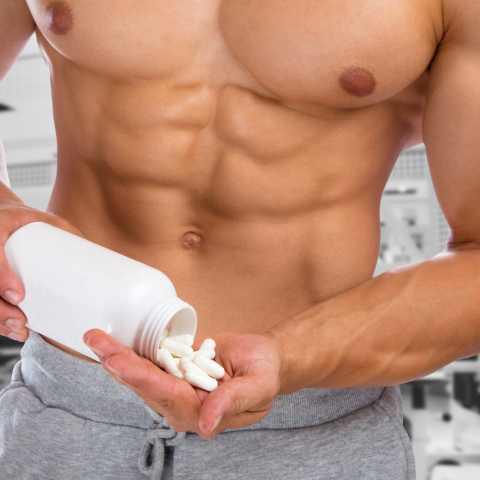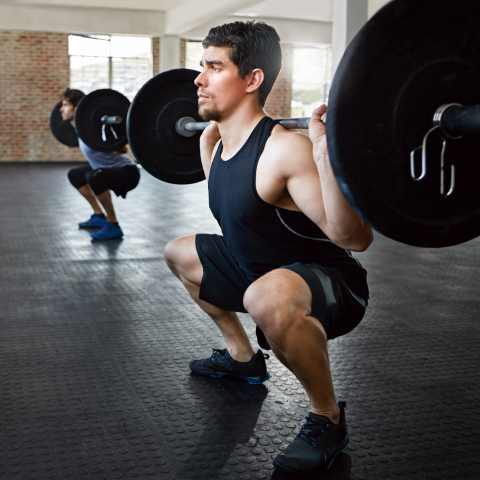Squats are arguably the perfect compound exercise for constructing strength and mass. Along with working the whole lower body, squats also work your back, core, and stabilizer muscles that help maintain posture and perform the fundamental movements required in life.
So we all know squats are great for constructing mass and improving your overall ability to operate, but do their advantages extend beyond gaining muscle? In this text, we’ll explore whether doing squats increases testosterone, the male sex hormone (it impacts you too, ladies) that plays a task in your overall mood, energy, and talent to take care of or gain muscle, amongst many other things.
Does doing squats increase testosterone? We’re about to seek out out!
Table of Contents:
- What Is Testosterone?
- Does Squatting Increase Testosterone?
- Squats And Testosterone: A Personal Trainer’s Perspective
- Other Advantages Of Squats
- Signs of Low Testosterone
- Other Strategies For Increasing Testosterone
- What Are The Best Testosterone Boosters?
- FAQs
What Is Testosterone?
Testosterone is one in all the androgens, or anabolic hormones, that’s accountable for the expansion and development of the male sex characteristics. Although testosterone supports the expansion of male characteristics, women even have testosterone in smaller amounts. Testosterone is produced primarily within the gonads, that are within the testes in males and ovaries in women, in addition to in small amounts from the adrenal glands. Testosterone’s role begins at birth, where it determines a baby’s sex in fetal development.
During puberty, testosterone levels drastically increase in males to assist the expansion and development of primary and secondary male characteristics. This includes growth of height, growth of body and pubic hair, the deepening of the voice, an increased libido, and a rise in the expansion of reproductive organs, including the prostate gland. In male maturity, testosterone plays a big role in maintaining a healthy sex life, muscle growth, creating latest red blood cells, and improving overall health.
In women, a lot of the testosterone is of course converted to the feminine sex hormone estradiol. Testosterone is vital in women since it plays an important role of their libido, balancing other hormones, maintaining bone density, creating latest red blood cells, correcting the menstrual cycle, and overall well-being.
You possibly can read more about this in our article: Low Testosterone In Women: Does It Harm Your Health?
Does Squatting Increase Testosterone?
Yes! Squats are among the finest, if not the perfect, exercises to extend testosterone production. Countless studies have confirmed that resistance training can increase testosterone levels, but various aspects affect the extent of the rise. Heavy resistance training has been shown to cause increases in serum testosterone levels almost immediately, but the degrees often return to normal thirty minutes post-workout1.
Nonetheless, further studies have shown that resistance exercise of small muscle groups doesn’t elevate testosterone levels in the way in which that resistance of major muscle groups does, like with a squat. In a single study, researchers noticed that single-arm dumbbell bicep curls didn’t affect plasma testosterone levels; nonetheless, the group that performed legs and arms had a more significant increase in plasma testosterone and growth hormone2.
One other aspect of squats that determines the extent of testosterone response is that if the exercise is performed with free weights in comparison with machine weight exercises.
One study examined the hormonal response of barbell squats in comparison with machine leg presses. Ten lively weight-lifters, roughly 25 years old, performed six sets of 10 repetitions for every exercise, one week apart. There have been more significant increases in testosterone and human growth hormone levels with the barbell squat in comparison with the leg press3.
Research has also confirmed to maximise the rise in testosterone, a compound movement just like the squat must be done first before other resistance exercises.
One study compared the hormonal response of starting with a large-muscle group and progressing to small-muscle group exercises in comparison with the reverse. The outcomes showed that starting with a large-muscle group exercise just like the squat ends in more significant increases in serum testosterone and insulin-like growth factor (IGF-1)4. They concluded that squatting increased testosterone levels resulting from involving larger muscle groups, including the abdominal and stabilizer muscles.
One other major factor that impacts how much squatting increases testosterone is the repetition range, training volume, and rest period length between sets. One study compared the hormonal responses from various rep and rest periods. The outcomes showed that probably the most significant increases in testosterone occurred with ten repetitions and one minute of rest between sets. There was also a post-exercise increase in testosterone as much as half-hour after the workout5.
To maximise your testosterone levels, try performing free-weight squats as your first exercise, ideally within the ten-repetition range, with one minute of rest between sets. Don’t use ultra light weight here, either. Your 10 reps must be hard.
To learn more about boosting t-levels through exercise, try our article: Does Workout Out Increase Testosterone?

Squats And Testosterone: A Personal Trainer’s Perspective
I just went into detail about what research reveals, which is that yes, squats do boost your testosterone! One other interesting perspective is from Thomas DeLauer, a star personal trainer and health creator.
Take a take a look at his video below, which dives into squats, key aspects to contemplate, science-backed research, and his personal takeaways.
Advantages Of Squats
While squats are possibly the perfect exercise to extend testosterone levels, additionally they have several other advantages. Beyond hormonal advantages, other perks include:
- Promote Muscle Growth: Essentially the most obvious advantage of squatting is constructing muscle mass. Squats are a compound exercise that prompts several muscles, including the quadriceps, hamstrings, glutes, calves, abdominals, lower back, and stabilizing muscles. Exercises like squats that work multiple muscle groups are the perfect for constructing muscle mass.
- Help Weight Loss: One study compared the energy expenditure of eight popular resistance training exercises, including half-squat, incline leg press, leg extension, bench press, incline bench press, lat pulldown, tricep extension, and biceps curl. The outcomes showed that the half-squat burned significantly more calories than all other exercises6.
- Improve Posture: Squats are among the finest exercises to assist improve posture when done with proper form. Squats heavily involve the core muscles, including the abdominals, obliques, lower back, and erector spinae muscles. The erector spinae muscles are accountable for keeping your back straight and maintaining posture. The stabilizer muscles of the core help maintain balance during squats and good posture.
- Increase Mobility: Along with improving posture, squats help improve mobility. When squats are performed appropriately with a full range of motion, they assist strengthen and improve joint flexibility within the knees, hips, and ankles. This helps improve joint health and improves mobility for every day activities.
- Supports Bone Health: One study examined the effect of multi-joint exercises, including squats, bench presses, and deadlifts, on bone mineral density in college-age men and girls. The outcomes showed compound exercises, including squats, led to significant increases in bone mineral density7.
- Good For Cardiovascular Health: Any exercise helps improve cardiovascular health, and squatting is not any different. Squatting is a high-intensity type of resistance training that involves multiple muscle groups. Squats increase heart rate as well, if not higher, as any exercise, which is significant for maintaining a healthy heart.
Signs of Low Testosterone
By the point men reach 30, their testosterone levels start to say no by roughly 1% a yr. Similarly, women’s testosterone levels are roughly half of their peak by the point they reach menopause at roughly age 50. If you may have any of the signs of low testosterone levels you might have a low testosterone level.
Signs of low testosterone include:
- Low libido or decreased sex drive
- Lack of energy and feeling drained
- Lack of strength and muscle tone
- Lack of concentration
- Thinning hair
- Infertility
- Erectile dysfunction
- Depression or anxiety
- Dry, brittle skin
- Difficulty sleeping
Signs of low testosterone in women include the above plus irregular menstrual cycle, vaginal dryness, and infertility or trouble getting pregnant.
5 Additional Strategies For Increasing Testosterone
We understand that not everyone can do squats or heavy resistance training. Luckily, there are other ways to extend testosterone production naturally. These strategies include:
1) Running/Exercise Recurrently:
If resistance training and weight lifting aren’t your thing, you possibly can still increase testosterone levels by exercising. Studies have shown that aerobic exercise, like running, can elevate test levels.
Consistent exercise has been proven to cut back BMI and cause increases in serum testosterone levels. Studies have shown that high-intensity interval training may boost your testosterone8. You can even mix running and high-intensity training with these HIIT Treadmill Workouts.
2) Follow a healthy Food regimen:
Considered one of the best ways to assist control and increase testosterone levels is follow a balanced weight-reduction plan. Following a weight-reduction plan high in protein, leafy green vegetables, and healthy fats helps keep testosterone levels high.
To learn more or get some serious meal inspiration, try our High Protein Meal Plan.
3) Eat Testosterone-Boosting Foods:
Several foods may also help increase testosterone, including eggs, tuna, beans, pumpkin seeds, garlic, olive oil, beef, leafy green vegetables, pomegranate, fatty fish, cocoa products, shellfish, avocados, cherries, and berries.
4) Healthy Sleep Schedule:
Having a correct sleep schedule is significant for keeping testosterone levels high. A study from 2011 found that participants who got five hours of sleep or less had their testosterone levels drop by 10-15%9.
Make sure you get enough sleep to assist construct muscle and increase your testosterone.
5) Taking Herbs, Vitamins, and Minerals That Boost Testosterone:
Research has shown that there are several vitamins, minerals, and herbs that naturally raise testosterone levels. A few of these products include vitamin D, vitamin B6, zinc, magnesium, Ashwagandha, and Fenugreek, which we discuss intimately in our article: 8 Best Supplements To Increase Testosterone Naturally.
The most effective strategies is to take a testosterone booster, which mixes a mix of quality vitamins, minerals, and herbs to maximise test levels.

What Is The Best Testosterone Booster?
In relation to testosterone booster supplements, we discover that natural products are the safest and best. Several studies have shown the effectiveness of natural herbs, minerals, and vitamins for increasing testosterone.
Natural testosterone boosters often contain a mix of those research-backed ingredients. Products that use synthetic compounds or hormones can contain illegal or potentially harmful ingredients, so we prefer to stick with natural products.
The most effective overall natural testosterone-boosting products is TestoPrime. TestoPrime incorporates 12 all-natural, research-backed ingredients, including D-aspartic acid, Panax ginseng, KSM 66 Ashwagandha extract, fenugreek, green tea extract, pomegranate extract, vitamin D, zinc, vitamin B6, vitamin B5, garlic extract, and black pepper extract. This product goes through extensive third-party testing to verify its safety and purity. Additionally they offer a 100% money-back guarantee, so you possibly can try the product risk-free.
If you happen to’d prefer to explore more t-boosters, head to our article on the 7 Best Testosterone Booster Supplements.
And, if you happen to are in search of a substitute for a testosterone booster complement, there may be also testosterone substitute therapy (TRT), a treatment prescribed by a healthcare skilled that uses prescription hormones to assist increase testosterone levels.
You possibly can’t go fallacious with any of those 8 Best Online TRT Clinics. One of the effective and convenient TRT options is Fountain TRT. You possibly can follow this link to their online TRT evaluation to get the method began immediately.
You can even learn more about Fountain TRT in our Fountain TRT Review.
FAQs
On this section, we’ll answer among the most typical questions on exercises for exciting testosterone production.
How long after squats does testosterone increase?
Studies have shown that testosterone levels increase immediately after performing squats.
What are the signs of high testosterone in males?
Signs of high testosterone levels include increased libido, muscle mass, strength, and hair growth, in addition to deepening of the voice, oily skin, decreased body fat, and possibly mood swings or aggression.
Do deadlifts increase testosterone?
Yes, performing deadlifts is among the finest exercises to extend testosterone production because they’re a compound movement that works nearly the whole body. You possibly can try other top t-boosting moves in our article: 5 Best Exercises That Increase Testosterone.
Do push-ups increase testosterone?
Yes, push-ups can increase testosterone levels because they use multiple large muscle groups, including most of the upper body, as because the chest, shoulders, triceps, abdominals, and stabilizer muscles.
What exercise increases testosterone most?
Research shows that squats increase testosterone probably the most, particularly when performed first in your workout together with your total training load within the ten-repetition range.

Does Doing Squats Increase Testosterone? Key Takeaways
In relation to exercises that increase testosterone, research suggests that the squat is the perfect exercise. Testosterone levels play an important role in growth and development, living a healthy life, and reproduction for each men and girls. Testosterone levels naturally decline by age 30, so it is important to make use of natural techniques, including squatting, to assist raise levels.
Squats are a high-intensity exercise that involves large muscle groups and multi-joint movements to assist construct muscle. Squatting involves the lower body, back, core, and stabilizing muscles, all contributing to our balance and mobility. Studies have shown that squats exert more energy and elevate serum testosterone levels more significantly than other exercises, akin to the leg press. Squats are among the finest exercises to extend strength and mass, and so they provide several other health advantages.
Research has shown that to maximise your testosterone gains, perform squats as your first exercise of the day, within the ten-repetition range, with one minute of rest between sets. If squats aren’t your favorite, or you may have limitations with resistance training, there are other natural ways to extend testosterone. Some ways to naturally increase testosterone include other types of exercise, eating a balanced weight-reduction plan with testosterone-boosting foods, and having a healthy sleep schedule. You can even take natural vitamins, minerals, herbs, testosterone booster supplements, or try TRT.
Squats are an amazing option to help boost your testosterone, but if you happen to’re in search of more significant increases to your T-levels, pair compound lifts with one in all these 7 Best Testosterone Booster Supplements. One other great option to boost your testosterone without leaving your own home for an appointment is by working with a web based TRT clinic! Start by testing these 8 Best Online TRT Clinics.
References:
- Riachy, Ruba, et al. “Various Aspects May Modulate the Effect of Exercise on Testosterone Levels in Men.” Journal of Functional Morphology and Kinesiology, vol. 5, no. 4, 7 Nov. 2020, p. 81, www.ncbi.nlm.nih.gov/pmc/articles/PMC7739287/, https://doi.org/10.3390/jfmk5040081.
- Hansen, S., et al. “The Effect of Short-Term Strength Training on Human Skeletal Muscle: The Importance of Physiologically Elevated Hormone Levels.” Scandinavian Journal of Medicine & Science in Sports, vol. 11, no. 6, 1 Dec. 2001, pubmed.ncbi.nlm.nih.gov/11782267/, https://doi.org/10.1034/j.1600-0838.2001.110606.x.
- Shaner, Aaron A., et al. “The Acute Hormonal Response to Free Weight and Machine Weight Resistance Exercise.” Journal of Strength and Conditioning Research, vol. 28, no. 4, Apr. 2014, https://doi.org/10.1519/jsc.0000000000000317.
- Sheikholeslami-Vatani, Dariush, et al. “Comparison of the Effects of Resistance Exercise Orders on Variety of Repetitions, Serum IGF-1, Testosterone and Cortisol Levels in Normal-Weight and Obese Men.” Asian Journal of Sports Medicine, vol. 7, no. 1, 1 Mar. 2016, https://doi.org/10.5812/asjsm.30503.
- Kraemer, W. J., et al. “Hormonal and Growth Factor Responses to Heavy Resistance Exercise Protocols.” Journal of Applied Physiology, vol. 69, no. 4, 1 Oct. 1990, https://doi.org/10.1152/jappl.1990.69.4.1442.
- Reis, Victor Machado, et al. “Energy Cost of Isolated Resistance Exercises across Low- to High-Intensities.” PLOS ONE, vol. 12, no. 7, 24 July 2017, p. e0181311, https://doi.org/10.1371/journal.pone.0181311.
- Almstedt, Hawley C, et al. “Changes in Bone Mineral Density in Response to 24 Weeks of Resistance Training in College-Age Men and Women.” Journal of Strength and Conditioning Research, vol. 25, no. 4, Apr. 2011, https://doi.org/10.1519/jsc.0b013e3181d09e9d.
- Yeo, Jeong Kyun, et al. “Which Exercise Is Higher for Increasing Serum Testosterone Levels in Patients with Erectile Dysfunction?” The World Journal of Men’s Health, vol. 36, no. 2, 2018, p. 147, https://doi.org/10.5534/wjmh.17030.
- 22. Leproult, Rachel. “Effect of 1 Week of Sleep Restriction on Testosterone Levels in Young Healthy Men.” JAMA, vol. 305, no. 21, 1 June 2011, p. 2173, https://doi.org/10.1001/jama.2011.710.






